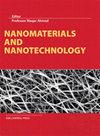Exfoliated graphene-alkaline lignin-PEDOT: PSS composite as a transparent conductive electrode
IF 3.3
3区 材料科学
Q2 MATERIALS SCIENCE, MULTIDISCIPLINARY
引用次数: 4
Abstract
In this work, we report a graphene-alkaline lignin-poly(3,4-ethylenedioxythiophene) polystyrene sulfonate composite as a transparent conductive electrode for indium tin oxide-free optoelectronic devices. The composite was prepared by dispersing exfoliated graphene-alkaline lignin into aqueous poly(3,4-ethylenedioxythiophene) polystyrene sulfonate. The effect of graphene concentration on the electrical and optical properties of graphene-alkaline lignin-poly(3,4- ethylenedioxythiophene) polystyrene sulfonate was studied. The graphene-alkaline lignin-poly(3,4- ethylenedioxythiophene) polystyrene sulfonate thin films exhibit excellent electrical conductivity and high transparency properties. The electrical conductivity is further increased by 1.9 ± 0.01 × 103 times when graphene content was augmented in the composites; however, the optical transparency was reduced due to the high optical absorbance of graphene. In this condition, the conductivity and optical transparency are as high as (4.19 ± 0.01) × 103 S/cm and 94.2%, respectively. This achievement is attributed to the organization of higher ordered network between conductive exfoliated graphene and poly(3,4-ethylenedioxythiophene) chains that induced a better conducting channel for charge transportation. The poly(3,4-ethylenedioxythiophene) chains act as a bridge connecting the graphene flakes, which, in turn, facilitate the movement of hole charges between them.剥离石墨烯-碱性木质素- pedot: PSS复合材料作为透明导电电极
在这项工作中,我们报道了一种石墨烯-碱性木质素-聚(3,4-亚乙基二氧噻吩)-聚苯乙烯磺酸盐复合材料,作为无铟锡氧化物光电器件的透明导电电极。将剥离的石墨烯碱性木质素分散到聚(3,4-亚乙基二氧噻吩)聚苯乙烯磺酸盐中制备了复合材料。研究了石墨烯浓度对石墨烯碱性木质素聚(3,4-亚乙基二氧噻吩)聚苯乙烯磺酸盐电学和光学性能的影响。石墨烯-碱性木质素-聚(3,4-亚乙基二氧噻吩)-聚苯乙烯磺酸盐薄膜具有良好的导电性和高透明度。当石墨烯含量增加时,复合材料的电导率进一步提高了1.9±0.01×103倍;然而,由于石墨烯的高光学吸收率,光学透明度降低。在这种条件下,电导率和光学透明度分别高达(4.19±0.01)×103S/cm和94.2%。这一成就归功于导电剥离石墨烯和聚(3,4-亚乙基二氧噻吩)链之间更高有序网络的组织,这为电荷传输引入了更好的导电通道。聚(3,4-亚乙基二氧噻吩)链充当连接石墨烯薄片的桥梁,从而促进空穴在它们之间的移动。
本文章由计算机程序翻译,如有差异,请以英文原文为准。
求助全文
约1分钟内获得全文
求助全文
来源期刊

Nanomaterials and Nanotechnology
NANOSCIENCE & NANOTECHNOLOGY-MATERIALS SCIENCE, MULTIDISCIPLINARY
CiteScore
7.20
自引率
21.60%
发文量
13
审稿时长
15 weeks
期刊介绍:
Nanomaterials and Nanotechnology is a JCR ranked, peer-reviewed open access journal addressed to a cross-disciplinary readership including scientists, researchers and professionals in both academia and industry with an interest in nanoscience and nanotechnology. The scope comprises (but is not limited to) the fundamental aspects and applications of nanoscience and nanotechnology
 求助内容:
求助内容: 应助结果提醒方式:
应助结果提醒方式:


